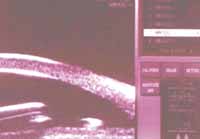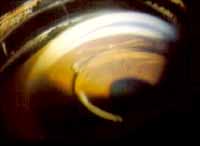Phakic 6H heparin-coated phakic IOL is effective for hyperopia
With flexible loops and a small optic edge, the angle-supported lens is well sized for the average hyperopic anterior chamber.
CANNES, France – The hyperopic Phakic 6H IOL (Ophthalmic Innovation International) has shown safety and efficacy over 3 years in European and Caribbean studies.
“We have introduced some small but significant changes in the lens. The loops are more delicate and more flexible, for easy, atraumatic insertion and for a more comfortable sitting in the angle. The optic edge is thin, so that even small anterior chambers can be implanted and there is ample clearance between the cornea and the anterior surface of the lens,” said Herbert Gould, MD, at the European Society of Cataract and Refractive Surgeons meeting here. The Phakic 6H is now in production and undergoing Food and Drug Administration phase 2 testing.
More clearance
 |
| UBM shows ample clearance of the IOL in the anterior chamber. |
 |
| Angle-view shows Phakic 6H haptics in position. |
 |
| The Phakic 6H IOL in the eye. |
According to Dr. Gould, professor of ophthalmology at the New York Medical College, angle-supported phakic IOLs are the best alternative procedure to corneal refractive treatment for correcting higher ametropias. Hyperopia in particular has very little to gain from corneal approaches, he said.
“There are more drawbacks than advantages in all the techniques that we have experienced so far. Even hyperopic LASIK has very poor results over 4 D and causes a worrying amount of topographic distortion. On the contrary, angle-supported phakic IOLs are well designed for hyperopia, as 75% of hyperopes, contrary to general opinion, have a normal anterior chamber, equal or more than 3 mm depth in the center,” he said.
Before implanting the lens, a case-by-case evaluation of anterior chamber depth is mandatory, both centrally and around the 3-mm optical zone, where the edge of the lens will sit. Scrutiny of the angle must also be done to evaluate angle clearance.
“In an adequate anterior chamber, the IOL is perfectly safe and delivers the optimal optical image. The 1 mm vault keeps at the right distance from both the iris and the cornea, and the haptic compression does not increase vaulting more than 0.1 mm. The 0.22-mm edges of the lens are also so thin that we can fit the lens into a slightly smaller anterior chamber and have extra safety margins,” Dr. Gould said.
Gentle fitting, no complications
The new Phakic 6H will be provided with haptics varying from 12 mm to 13 mm.
“In the past, with angle-supported IOLs there has been some evidence of slight pupil ovalization, which has always remained within the optical zone of the lens and was therefore not clinically important,” Dr. Gould said. “This kind of ovalization is mainly an aesthetic problem, and does not produce glare or visual disturbance at all. However, the improved flexibility of the loops in the Phakic 6H should reduce this occurrence even further.”
The haptics fit comfortably and steadily into the angle, he said. The 2- to 3-year results from studies worldwide showed no synechiae, inflammatory reaction or disruption of the iris by the lens. There was also agreement in the evaluation of visual acuity results and complication rate.
“The lens power ranges from 2 D to 10 D. Results generally show that, after implantation, patients can see without glasses as well as they could see with glasses before surgery. Postoperative uncorrected visual acuity coincides in most cases with preoperative best corrected visual acuity,” Dr. Gould said.
The same studies report no glaucoma, cataract or cases of explantation after more than 3 years. “The lens is extremely well tolerated by the eye thanks to the heparin coating, which enhances biocompatibility and prevents inflammation, cell proliferation and infection. There is always a possibility of infection when you implant a lens. The presence of this antibacterial and anti-inflammatory agent is a very important safety factor,” he said.
Endothelial stability is also very good, it is generally agreed. The average endothelial cell count decrease is less than 3%. At 2 years postoperatively, cell count is around 2,500 in most cases and remains stable at 3 to 4 years.
According to Dr. Gould, the insertion method of the Phakic 6H is easily mastered by any cataract surgeon. The design of the lens, with 6-mm optics and softer loops, makes the procedure even easier. Being a rigid IOL, the incision size must be 6.5 mm, but in his opinion this is no problem at all. “With good surgery you can have an astigmatic-neutral wound. However, because so many surgeons object to the incision size, we are now working at producing a flexible version of the lens,” he said.
A note from the editors: The Phakic 6H is not currently distributed in the United States.
For Your Information:
- Herbert Gould, MD, can be reached at 345 East 37th Street, New York, NY 10016; (212) 697-0827; fax: (212) 697-0823; e-mail: HLGould60@aol.com. Dr. Gould is a paid consultant for Ophthalmic Innovation International.
- Ophthalmic Innovation International, manufacturer of the Phakic 6H, can be reached at 550 N. Claremont Blvd., Claremont, CA 91711; (909) 626-4558; fax: (909) 626-7338.
